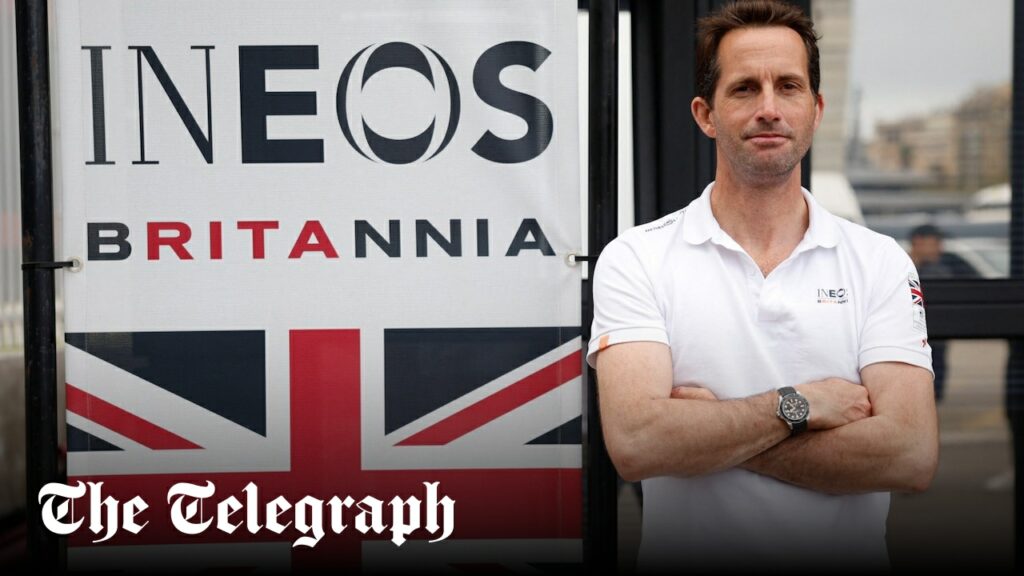How a race works
With three minutes to go, as long as the wind limit has not been breached (21 knots being the upper limit, and 6.5 knots the lower limit), the race will be declared ‘on’.
The ‘port entry’ boat, arriving from the left, is allowed to enter the start box – the defined race boundary laid out by the race organisers – with 2min 10sec to go.
It has to cross the start line from the windward side (ie. with the wind behind it, in the opposite direction to the first ‘upwind’ leg of the race).
The ‘starboard entry’ boat, arriving from the right, is permitted to enter the box with two minutes to go, at which point the pre-start jostling for position begins.
Teams use a tactical app to help them get their time and distance spot on. Any early entry will be penalised.
Boats may try to engage each other in the pre-start to try to force a penalty, or gain an advantageous position, with the ultimate aim to hit the line bang on time while hurting your rivals’ chances of doing so.
Crossing early is a no no as that means you are ‘OCS’ (on course side) and will result in a penalty of 75m relative to the other boat. Penalties are applied electronically. Once you have dropped back sufficiently your penalty will be ‘cleared’.
There are then a number of upwind and downwind legs (usually six but this will depend on the strength of the wind. In heavy winds it could go up to eight legs), with the total race time intended to be around 25 minutes.
If the race is not completed within 45 minutes – if the breeze drops away for instance – the race is declared null and void.
There are gates at the top and bottom of the course. You can choose to go either way once you have gone through the gate. The trailing boat will often ‘split’ the course, or head out in the opposite direction to the lead boat, in order to try to get some clear air and make a gain, rather than just follow the other boat around.
Legs can be lengthened or shortened in-race, and the gates moved, if the wind strength or direction changes significantly.
Who are the skippers?
For Ineos Britannia, Ben Ainslie is the most successful Olympic sailor of all-time (4 x gold, 1 x silver), as well as a former match racing world champion. He has won one America’s Cup as a tactician, aboard Oracle Team USA, and is now challenging for the third time with his own team.
For Emirates Team New Zealand, Peter Burling is a Kiwi prodigy. He was the youngest 49er sailor at the London Olympics (aged 21) where he won silver with Blair Tuke, the youngest 49er gold medal-winning skipper in Rio (25), the youngest helmsman to win the America’s Cup in Bermuda in 2017 (26) and the youngest to defend it in Auckland (30), when he also took over as skipper of Emirates Team New Zealand.
In terms of styles, it is fair to say Ainslie is the more aggressive. He is likely to try to engage the New Zealand boat in the pre-starts, as he did with Luna Rossa in the challenger series final to good effect.
New Zealand, who are super smooth through manoeuvres and will start the Cup as favourites, are likely to try to keep their noses clean and then assert themselves in the race. But that could all go out the window depending on who has the quicker boat.
Source link : http://www.bing.com/news/apiclick.aspx?ref=FexRss&aid=&tid=670a3af74fd744b595d89f90e0407854&url=https%3A%2F%2Fwww.telegraph.co.uk%2Fsailing%2F2024%2F10%2F12%2Famericas-cup-2024-what-is-it-how-does-it-work-race-schedule%2F&c=8506312701237471415&mkt=en-us
Author :
Publish date : 2024-10-11 21:19:00
Copyright for syndicated content belongs to the linked Source.
